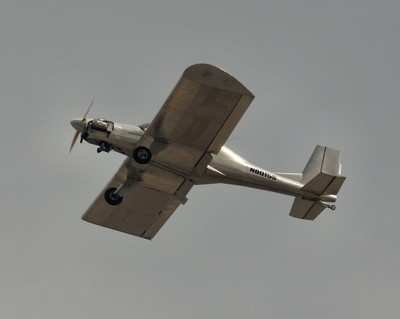Pilot Was Fatally Injured When The Experimental Aircraft Went Down
The NTSB has released a factual report from an accident that occurred May 9, 2012, at DeFuniak Springs Airport (54J), DeFuniak Springs, Florida. The commercial-rated pilot of an EA-B Gutierrez Hummel Bird airplane was fatally injured when the plane went down.

According to the report, an eyewitness observed the pilot performing maintenance to the airplane prior to the flight. One of the witnesses stated that he observed the pilot conduct a lengthy preflight before starting the engine by hand, followed by a ground engine run-up, and then taxi to runway 27. Witnesses observed the airplane accelerate, roll down the runway, rotate, and climb about 30 to 40 feet above the runway when the airplane started varying its altitude. They watched as the airplane porpoised a few times as it continued to climb. When it reached an estimated altitude of 300 feet above ground level (agl), it pitched nose high and rolled to the right. The airplane nosedived and collided with the ground in an approximate 80 degree nose-down attitude. The airplane came to rest on its main gear in the upright position facing 120-degrees from the departing runway.
The pilot, age 77, held a commercial pilot certificate with ratings for airplane single-engine and multi-engine land, and instrument airplane. He held a flight instructor certificate for airplane single-engine land. He was issued a third-class medical certificate on April 10, 2012, with the limitation of a special time limited; however, in a letter mailed to the airman on May 5, 2012, the Federal Aviation Administration (FAA) withdrew his medical certificate. A review of his pilot logbook revealed the most recent entry was dated March 15, 2012 and at that time he had 527.5 total hours of flight experience, of which 0.3 of those hours were in the accident airplane make and model. The most recent recorded flight review was dated August 22, 1997; however, in February and March of 2012, there were three entries with a flight instructor signature associated with them that listed a variety of training, including; "takeoff and landings, emergency procedures, failures" to list a few.
The single-seat, low wing, all metal construction, fixed-gear airplane, serial number 001, was manufactured in 2012. It was powered by a 37-hp, 2-cylinder Hummel Engine, which consisted of 1/2 of a Volkswagen engine, and a Culver 2-bladed wooden propeller. Review of photographs of the airframe maintenance records revealed a conditional inspection was recorded by the accident pilot on January 9, 2010. The airplane was issued a special airworthiness certificate on January 10, 2010. The most recent airframe maintenance logbook entry was dated April 12, 2012, with a recorded tachometer time of 7.7 hours and stated, "Adjusted horizontal stabilizer = increase nose-down pitch." The entry was signed by the accident pilot. The most recent engine maintenance logbook entry was dated March 24, 2010, with a recorded tachometer time of 3.0 hours.
According to fuel records provided by the airport, the most recent fuel purchase by the pilot was for 1.94 gallons of fuel on April 16, 2012.
A review of the pilot's FAA medical records showed that on May 5, 2012, a letter was issued to the pilot that withdrew his medicate certificate issued on April 10, 2012; due to a recent change in the medication the pilot was consuming for his medical condition. The certified letter was delivered to the pilot's residence on May 10, 2012.
According to information provided by the FAA Office of Aerospace Medicine, a letter from the Aviation Medical Examiner (AME) reported that during the most recent medical exam the pilot told the AME that "…he was having great difficulty with longitudinal stability, and was unable to complete even one pattern after multiple attempts. More than one of these attempted test flights ended with forced landings, and damage to the aircraft such that it had to be carried back to his hangar for repair. He noted his weight gain caused him to be 'over gross' most likely causing his control problem." The AME further reported that he had "advised the pilot, as did other friends, to stop trying to fly this plane and simply get a larger aircraft capable of carrying him."
According to documentation located with the airplane maintenance records, a center of gravity calculations form was located. The form, dated June 2, 2011, indicated that the empty weight of the aircraft was 333 pounds, and that weight did not include the weight of the pilot or the fuel. The form also indicated that the center of gravity (CG) limits were 8.25 – 11.25 inches rear of datum and a maximum gross weight of 530 pounds. When calculating the weight, utilizing the pilot's most recent medical information and 2 gallons of fuel, the takeoff weight was 561.2 pounds with a CG of 11.14 inches rear of datum. When calculating the weight, as above, except with full fuel the takeoff weight was 588 pounds and a CG of 10.216 inches rear of datum.
(Hummel Bird pictured in file photo. Not accident airplane)
 ANN's Daily Aero-Linx (04.16.24)
ANN's Daily Aero-Linx (04.16.24) Aero-News: Quote of the Day (04.16.24)
Aero-News: Quote of the Day (04.16.24) Airborne 04.10.24: SnF24!, A50 Heritage Reveal, HeliCycle!, Montaer MC-01
Airborne 04.10.24: SnF24!, A50 Heritage Reveal, HeliCycle!, Montaer MC-01 Airborne 04.12.24: SnF24!, G100UL Is Here, Holy Micro, Plane Tags
Airborne 04.12.24: SnF24!, G100UL Is Here, Holy Micro, Plane Tags Airborne-Flight Training 04.17.24: Feds Need Controllers, Spirit Delay, Redbird
Airborne-Flight Training 04.17.24: Feds Need Controllers, Spirit Delay, Redbird



